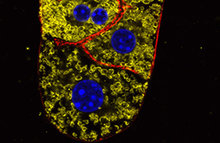Munich, 14.10.2019
Discovery of potential novel therapeutic target for non-alcoholic fatty liver disease
One of the key comorbidities of type-2-diabetes is non-alcoholic fatty liver disease (NAFLD). With an increasing prevalence worldwide and no treatment options available today, NAFLD paves the way to more severe liver damage such as cirrhosis and hepatocellular carcinoma. A group of researchers including the Institute for Diabetes and Cancer at Helmholtz Zentrum München has discovered a potential novel therapeutic target for treating NAFLD: Rab24. The paper was published in 'Nature Metabolism'.
Rab24 is a small Rab GTPase, which was found to be a novel regulator of mitochondrial activity and plasticity. The group of researchers lead by diabetes researcher Anja Zeigerer showed that it is highly upregulated in the liver of obese patients with NAFLD. In a next step, they were able to demonstrate that by reducing Rab24 in models of diet induced obesity, liver steatosis and glucose tolerance are strongly improved. This indicates a general improvement of liver and systemic health. Rab24 is therefore a potential novel therapeutic target for treating NAFLD.
“The incidence of type-2-diabetes and its comorbidities, such as NAFLD, is increasing tremendously. NAFLD is affecting 1.8 billion people worldwide, with no approved treatment options on the market. Thus, finding novel intracellular targets such as Rab24 for possible therapeutic options is very much needed,” says Anja Zeigerer.
Less Rab24, better mitochondrial function
Searching for new targets for therapeutic options, the group of Anja Zeigerer focused on compons of the intracellular trafficking and organelle maintenance machinery. The group screened novel functions of trafficking candidates in their control of liver glucose and lipid homeostasis and found Rab24 as a novel regulator of mitochondrial dynamics and energy metabolism.
Mitochondrial dynamics is strongly regulated by mitochondria plasticity and turnover, which is controlled by nutrient availabilities. Fasting inhibits mitochondria fission and induces hyperfused and more functional mitochondria that can use any available substrates for energy production. In metabolic diseases, with constant metabolic oversupply, mitochondria are fragmented and are incapable of proper respiration and activity.
The group found that Rab24 interferes with the machinery that is responsible for mitochondrial fission and that by decreasing Rab24, mitochondria are more connected and therefore more functional. Importantly, they saw that Rab24 was highly upregulated in the liver of obese patients with NAFLD. This could participate to the fragmented mitochondria and the upregulation of energy storage in these patients. The data gathered from reducing Rab24 in models of diet induced obesity offer the prospect of a therapeutic application of trafficking regulators – such as Rab24 for NAFLD. Further, the findings also highlight a functional connection between intracellular trafficking and systemic metabolic dysfunction.
“In a next step, we want to explore Rab24 as a potential therapeutic target for NAFLD in more detail. We will investigate inhibitors of Rab24’s effect on mitochondrial fission and test whether such inhibitors could mimic the observed improvements of this study”, explains Susanne Seitz, first-author of the paper.
Strong intra-institutional collaboration and funding
This study, pioneered at the Institute for Diabetes and Cancer, headed by Prof. Stephan Herzig, strongly benefits from the infrastructure at Helmholtz Zentrum München: It was inspired through a collaboration with the German Mouse Clinic and Prof. Martin Hrabe de Angelis from the Institute of Experimental Genetics. It was supported by the satellite institute in Leipzig, in collaboration with Prof. Matthias Blüher, who provided valuable human samples for expression analyses. The project was further supported by Deutsche Forschungsgemeinschaft (DFG), European Diabetes Foundation (EFSD) and Deutsches Zentrum für Diabetesforschung (DZD) research grants.
Original publication
Anja Zeigerer et al., 2019: Hepatic Rab24 controls blood glucose homeostasis via improving mitochondrial plasticity. Nature Metabolism, DOI: 10.1038/s42255-019-0124-x
As German Research Center for Environmental Health, Helmholtz Zentrum München pursues the goal of developing personalized medical approaches for the prevention and therapy of major common diseases such as diabetes mellitus, allergies and lung diseases. To achieve this, it investigates the interaction of genetics, environmental factors and lifestyle. The Helmholtz Zentrum München has about 2,500 staff members and is headquartered in Neuherberg in the north of Munich. Helmholtz Zentrum München is a member of the Helmholtz Association, a community of 19 scientific-technical and medical-biological research centers with a total of about 37,000 staff members.
The Institute for Diabetes and Cancer (IDC) is a member of the Helmholtz Diabetes Center (HDC) at the Helmholtz Zentrum München and a partner in the joint Heidelberg-IDC Translational Diabetes Program. The Institute for Diabetes and Cancer is tightly integrated into the German Center for Diabetes Research (DZD) and into the special research area "Reactive Metabolites and Diabetic Complications" at the Heidelberg University Medical School. The IDC conducts research on the molecular basis of severe metabolic disorders, including metabolic syndrome and type 2 diabetes, as well as their roles in tumor initiation and progression.
Press contact

Birgit Niesing
niesing(at)dzd-ev.de
+49 (0)89 3187-3971

